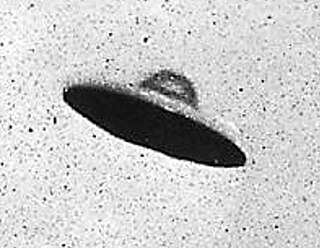
An unidentified flying object (UFO), or unidentified anomalous phenomenon (UAP), is any perceived airborne, submerged or transmedium phenomenon that cannot be immediately identified or explained. Upon investigation, most UFOs are identified as known objects or atmospheric phenomena, while a small number remain unexplained.

Georges Charpak was a Polish-born French physicist who received the Nobel Prize in Physics in 1992 for his invention of the multiwire proportional chamber.

Homero Rómulo Cristalli Frasnelli, better known under the pseudonym J. Posadas or sometimes Juan Posadas, was an Argentine Trotskyist whose personal vision is usually described as Posadism. Originally a collective pen name of the leadership of the Grupo Cuarta Internacional in Argentina in the 1940s, it was also used by Dante Minazzoli initially.

The Fourth International Posadist is a Trotskyist international organisation. It was founded in 1962 by J. Posadas, who had been the leader of the Latin America Bureau of the Fourth International in the 1950s, and of the Fourth International's section in Argentina. Between their split from the International Secretariat of the Fourth International in 1962 and Posadas' death in 1981, Posadists developed a strain of communism that included several fringe ideas, which brought them into conflict with more mainstream left-wing groups.

Henri René Guieu was a French science fiction writer and ufologist, who published primarily with the pseudonym Jimmy Guieu. He occasionally used other pseudonyms as well, including Claude Vauzière for a young adult series, Jimmy G. Quint for a number of espionage novels, Claude Rostaing for two detective novels and Dominique Verseau for six erotic novels.
In ufology, the psychosocial hypothesis, abbreviated PSH, argues that at least some UFO reports are best explained by psychological or social means. It is often contrasted with the better-known extraterrestrial hypothesis (ETH), and is particularly popular among UFO researchers in the United Kingdom, such as David Clarke, Hilary Evans, the editors of Magonia magazine, and many of the contributors to Fortean Times magazine. It has also been popular in France since the publication in 1977 of a book written by Michel Monnerie, Et si les ovnis n'existaient pas?.

The Nancy School was a French hypnosis-centered school of psychotherapy. The origins of the thoughts were brought about by Ambroise-Auguste Liébeault in 1866, in Nancy, France. Through his publications and therapy sessions he was able to gain the attention/support from Hippolyte Bernheim: another Nancy Doctor that further evolved Liébeault's thoughts and practices to form what is known as the Nancy School.

A flying saucer, or flying disc, is a purported disc-shaped UFO. The term was coined in 1947 by the U.S. news media for the objects pilot Kenneth Arnold claimed flew alongside his airplane above Washington State. Newspapers reported Arnold's story with speed estimates implausible for aircraft of the period. The story preceded a wave of hundreds of sightings across the United States, including the Roswell incident and the Flight 105 UFO sighting. The concept quickly spread to other countries. Early reports speculated about secret military technology, but flying saucers became synonymous with aliens by 1950. The more general military terms unidentified flying object (UFO) and unidentified anomalous phenomena (UAP) have gradually replaced the term over time.

Starship Invasions is a 1977 Canadian science fiction film directed, produced and written by Ed Hunt and filmed in Toronto, Ontario. It was re-released in the United Kingdom as Project Genocide.
Mikkel Borch-Jacobsen is a professor of Comparative Literature and French at the University of Washington in Seattle, and the author of many works on the history and philosophy of psychiatry, psychoanalysis and hypnosis. Born to Danish parents, he began his studies in France and emigrated to the United States in 1986. His constructivist analysis of the co-production of psychical "facts" emphasises the accuracy of historical accounts of mental disorders.
Aimé Michel was a French UFO specialist, science and spirituality writer and author.

Robert Misrahi was a French philosopher who specialised in the work of 17th Century Dutch thinker Baruch Spinoza.

Vinciane Despret is a Belgian philosopher of science. She is an associate professor at the University of Liège and also teaches at the Université libre de Bruxelles.
Raymond de Saussure was a Swiss psychoanalyst, the first president of the European Psychoanalytical Federation. He is the son of the famous linguist Ferdinand de Saussure, and a student of Sigmund Freud.
François Dagognet was a 20th-century French philosopher.
Moncef Chelli, , was a Franco-Tunisian philosopher and writer.

René Schérer was a French philosopher and professor emeritus of the universite de Paris VIII.
Jean-Pierre Dupuy is a French engineer and philosopher.

Jean Garrabé was a French psychiatrist.
Madeleine Akrich is a French sociologist of technology. She served as the director of the Center for the Sociology of Innovation at Mines ParisTech from 2003 to 2013. She is known for developing actor–network theory (ANT) with Bruno Latour, Michel Callon, John Law and others.











